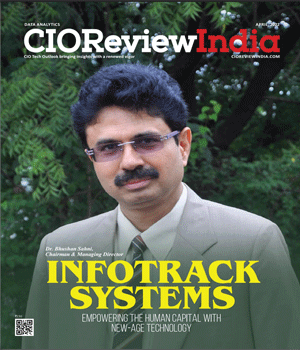
The Need for Robust Data Center Policies and Governance Structure
Prasanna Sarambale, CEO Data Center Business, Sterling & Wilson | Friday, 20 March 2020, 11:57 IST

According to a report by Technavio, the global data centre market is expected to become USD 288.44 billion by 2023. What is your perspective on this market trend and how do you see the business opportunities in India?
Industry reports slot India data center market size in the region of approximately US $4 Billion by 2024. And, the market is likely to grow at a CAGR of around 9% between 2020 and 2024. The volume of worldwide data generation is set to grow from 41 Zettabytes (ZB) in 2019 to 175 ZB by 2025. India's data usage per smartphone is the highest in the world at 9.8GB/month and is predicted to double by 2024.
However, India only shares around 1.8% of the global data center IT infrastructure. As growth rates in mature data center markets slow down and demand starts to pick up in the APAC markets, India stands to exploit this market the most. Powered by the government of India’s vision to create a digital economy worth $1 trillion, the new-age tech is going to touch and influence every sector of the economy and soon emergence of disruptive ways of doing business would be even more frequent. To support this explosive growth, the country needs a robust Data Center policies and governance structure that meet global standards, helping the country maintain its competitive position in the IT space.
Indian government’s move for data localization in India aims to ensure the storage of data on a server or data centre located in India, of at least one serving copy of personal data in India. What would be the future scenario if the data localization bill becomes an act?
If the bill gets passed, it will have a positive impact on the Data Centre Business in India. As technology or a new economy leads to the next level of growth for the country, the data localisation move is in the right direction. Many of the developed economies already have the necessary regulations and infrastructure for the localisation of data. Also, due to increasing data sensitivity coupled with regulations, most companies will need to set up their data centers in India, further driving the growth in the market. We can see this trend in the Telecom, Government and BFSI sectors, where data centres are fast becoming critical infrastructure, given the vast amount of sensitive data that needs to be stored and processed.
The 2020 Union Budget has intended to give a necessary boost to the industry. The new Data Centre parks proposed will ensure sustainable growth not only for the sector but also for the country.
The evolution of cloud computing technologies has reinvented the data centre landscape making way for compact data centres with advanced facilities in the place of conventional data centres. What will be the role of compact data centres in addressing the needs of modern-day businesses?
The evolution of cloud computing or off-premises computing has certainly led to the evolution of Edge data centres of smaller form factor. At the same time, the rack power densities have increased due to the growing use of hyper-converged infrastructure. With rising internet usage, there has been an increase in the demand for information. The use of information technology in social networking and businesses like telecommunication, retailers, finance, OTT’s in various business processes generates a huge amount of data every hour which needs to be processed and acted upon with a minimum possible latency. At the same time, consumers certainly expect data protection from cyber threats like Denial of Service (DoS), data leakage, etc.
This demand from the consumers have further given rise to the IT security business and secured edge data centre infrastructure where the data is processed and stored near to the consumers, hence serving them with the minimum latency possible and customer delights.
However, edge as a proposition must be a strategic decision. Organisation must define its operation methodology and then make a go-to-market combination of conventional and edge DCs to meet its business goal. An edge DC can cater to applications where latency needs mitigation. At the same time, it needs to exchange data with a conventional setup to upload the generated data. So, both conventional and edge will continue to have their importance in the data centre ecosystem.
Some of the security threats to data centres include DDoS Attacks, Web Application Attacks, SSL-induced Security Blind Spots, etc. How does technology help to enhance security of the data centres by addressing the security issues?
In Data Centres, seven layers of security in physical and logical areas, as follows, are considered:
- Physical Security
- Internet Security
- Perimeter Security
- Network Security
- Systems Security
- Application Security
- Data Security
Physical Security: Advanced physical security program to safeguard assets against a physical event, from theft to a natural disaster. Data centres utilize physical security solutions like Turnstiles, Scanners, Biometrics Readers, IR Cameras, etc.
Internet Security: Anti-DDoS service provides real-time internet threat intelligence through continuous monitoring and comprehensive coverage against volumetric and application-layer attacks.
Perimeter Security: Firewall keeps unauthorized intruders out and sensitive, mission-critical data in. A data centre must have Virtual Private Network (VPN) when communicating with authorized users outside the network through encryption and remote access.
Network Security: Network Intrusion Detection System quickly detects and responds to threats through 24x7x365 monitoring in a hybrid IT environment.
Systems Security: The ability to automate log collection and search in real-time enables easy and scalable security support.
Application Security: Web application firewalls (WAFs) analyse incoming traffic and intercept attacks.
Data Security: Data encryption, compliant and scalable, enables security of sensitive data and coordinate security measures across various systems and devices.
Artificial Intelligence is revolutionizing the data centre landscape by automating the tasks to improve accuracy and process efficiency. AI through predictive analytics helps to optimize the distribution of workload. How do you see the scope of AI in addressing skill shortage problems and improving the efficiency of data centres to cater to the ever-changing needs of businesses?
Servers and data centers as a unit have smart systems that help operate efficiently & gain micro-level control on each aspect. Operators need to make a business case to understand whether such automation would really be of effect and decide accordingly. Also, customer requirements may have to be factored when creating scenarios.
From a skill shortage perspective, it is yet to be seen. Once we have enough use cases, DC operators can take a holistic approach to address the talent gaps.
CIO Viewpoint
Accept Data as an Entity on Balance sheet
By Akshey Gupta, Chief Data Officer, Bandhan Bank
Technology Forecast And Concern In 2020
By Anil Kumar Ranjan, Head IT, Macawber Beekay Private Limited
Data Analytics For Enhanced Productivity And...
By Krishnakumar Madhavan, Head IT, KLA
CXO Insights
Regulatory Implications and Data Protection:...
By Richa Singh
Data-Driven Predictive Technologies
By Pankaj Parimal, Head of Launch & Change Management, Hella Automotive Mexico, S.A. de C.V., Mexico, North America.
5 Mantras That Can Drive Organizations Towards...








.jpg)
.jpg)





